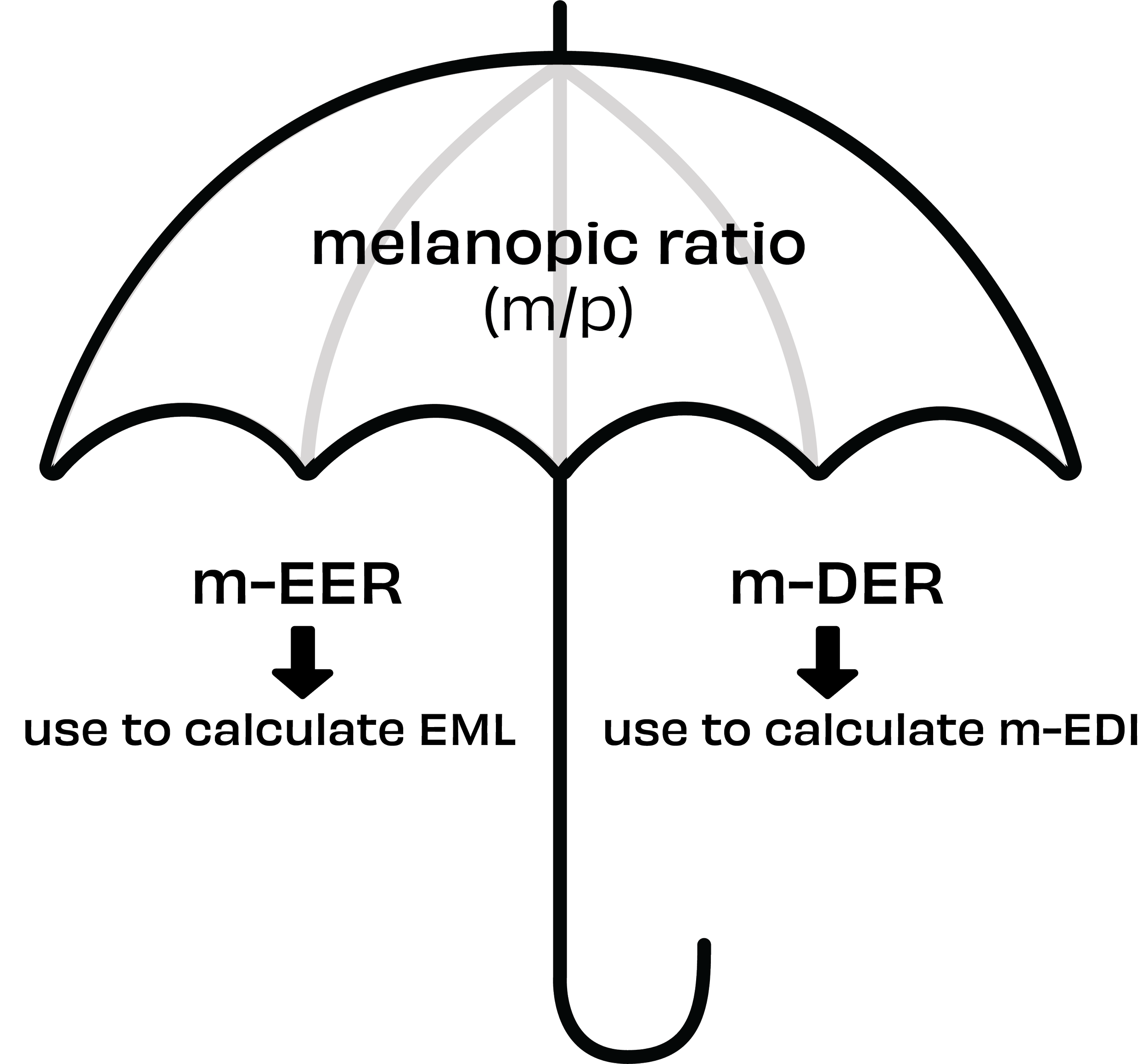How to Calculate Melanopic Ratio
Melanopic ratio (m/p) can be a confusing term thrown around in wellness lighting because people often talk about it as a single metric, but it is not.
In reality, there are four (4) different types of m/p ratio.
The bad news:
We use two (2) of these to measure wellness lighting — m-DER and m-EER
The good news:
You only need to learn about one (1) of those types of melanopic ratio (m/p) to start measuring wellness lighting today.
You can also use either m-DER or m-EER for WELL™ Circadian Lighting Feature L03 documentation.
The IWBI provides a free calculator anyone can use to calculate m-EER.
For detailed information on the four (4) types of melanopic ratio (m/p) please see this paper authored by Naomi Miller from PNNL.
Let’s Dive In
First, decide if you want to measure EML (which uses m-EER as the m/p) or if you want to measure m-EDI (which use m-DER as the m/p).
Melanopic Ratio is an “umbrella” term.
It describes a concept for evaluating the melanopic content of an SPD vs the photopic (visual) content.
M-EER and M-DER are both melanopic ratios, but they are calculated in slightly different ways.
THEY CANNOT BE USED INTERCHANGEABLY.
We use m-EER to calculate EML
We use m-DER to calculate m-EDI
Both m-EER and m-DER are accepted methods for calculating the melanopic ratio of a light source.
** PRO TIP - The IWBI Calculator for m-EER is more user friendly than the CIE Toolbox that gives you m-DER **
Scroll through this article and follow the steps for the type of melanopic (m/p) ratio you want to use.
Melanopic Ratio: m-EER
This section gives you simple steps to determine the melanopic ratio (m/p), based on the Lucas model, “m-EER” for any light source.
What you need
Download the IWBI Calculator - Click on this link for the free calculator, download the .xlsx file, save in a memorable place on your computer.
Reminder: This calculator is only used for m-EER, which is the melanopic ratio used to determine EML (Equivalent Melanopic Lux).
DON’T WORRY YOU CAN’T BREAK THE SPREADSHEET!
You only have control of specific cells, so you really can’t mess this up!
SPD - Ask the lighting manufacturer or your local sales agency for the spectral power distribution (SPD) for the light source you want to use.
Make sure you ask for table data for each specific CCT and light source. For example - If you are looking at two (2) different LEDs and two (2) different CCTs: you need four (4) different SPDs.
LED Chip 1 @ 3000K
LED Chip 1 @ 3500K
LED Chip 2 @ 3000K
LED Chip 2 @ 3500K.
Ask for the SPD in a table format (excel spreadsheet) and with measurements at every one nanometer or five nanometer increments. This is information is required so you can copy/paste the raw values into the calculator and it will output the melanopic ratio for the light source at the specific CCT.
Copy / Paste Data - Copy and paste your table values into the calculator in the “Data” Tab at the bottom of the spreadsheet.
** PRO-TIP - Label Your Source File **
Update the first row text to include CCT and Light Source/Manufacturer for the SPD you input
Select from Drop Down - To reveal your M/P ratio, click on the “Circadian” tab at the bottom of the spreadsheet. Go to the ‘Source’ drop-down menu in column ‘H’ and select the light source you just added.
M/P Output - Look at cell ‘J2’ and you will see the melanopic ratio (m-EER) for the selected light source in cell ‘H2’.
REAL TALK
The hardest part of this is usually getting the SPD data. We may be able to help!
Get in TouchHave questions, please leave a comment so we can help!
Melanopic Ratio: m-DER
This section outlines the step for using the CIE Alpha Opic Toolbox to determine the melanopic ratio (m-DER) for any light source.
WELL™ Feature L03 allows you to use another type of melanopic ratio (m/p) called “m-DER”. This ratio was published by the CIE in The International Standard CIE S 026/E:2018.
To calculate melanopic ratio using the CIE model, you can download their free online ‘toolbox’ to get m-DER and other detailed metrics for any light source.
** WARNING **
THIS IS NOT THE MOST USER FRIENDLY TOOLBOX.
You will learn how to use the CIE S 026 toolbox in this article, but if you would like to avoid that experience, there is a simple way to convert m-EER to m-DER.
m-DER vales are simply ~10% lower than m-EER values
This means 0.90 m-DER ≈ 1.0 m-EER
CIE TOOLBOX LINK AND STEPS COMING SOON
REAL TALK
The hardest part of this is usually getting the SPD data. We may be able to help!
Get in TouchHave questions, please leave a comment below.
